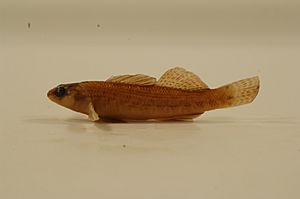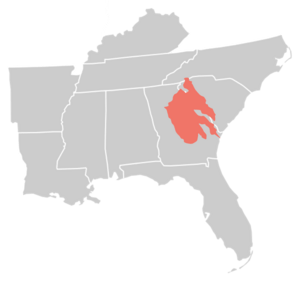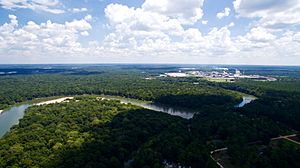Christmas darter facts for kids
Quick facts for kids Christmas darter |
|
|---|---|
 |
|
| Conservation status | |
| Scientific classification | |
 |
|
| Synonyms | |
|
Poecilichthys hopkinsi Fowler, 1945 |
The Christmas darter (Etheostoma hopkinsi) is a small, colorful fish that lives in rivers. It's a type of ray-finned fish called a darter. Darters are part of the Percidae family, which also includes perches.
This fish gets its name, "Christmas darter," because of its bright red and green colors. These colors are especially noticeable in the males. It's usually less than 5 cm (2 in) long.
You can find the Christmas darter in the Savannah, Ogeechee, and Altamaha river areas. These rivers are located in South Carolina and Georgia, in the United States.
Like other darters, it prefers to live on the bottom of streams. It likes fast-moving parts of rivers called riffles. It also lives in areas with lots of plants in small rivers, creeks, and spring-fed streams. The Christmas darter eats aquatic insects.
Scientists believe it lays its eggs in the spring. However, much about its daily life and habits is still a mystery. The Christmas darter is related to the Savannah darter. It is also related to the Christmas Eve darter. Some people think the Christmas Eve darter is a type of Christmas darter.
The Christmas darter is a common fish where it lives. Because of this, it is not currently considered in danger of extinction. The International Union for the Conservation of Nature (IUCN) says it is a species of "least concern."
Contents
About the Christmas Darter
What is a Darter?
Darters are small fish that often rest on the bottom of rivers and streams. They have special fins that help them lift off the ground when they swim. Unlike many fish, they don't have a very developed swim bladder. A swim bladder is an organ that helps fish float. Because their swim bladders are small, darters stay close to the riverbed.
How it Got its Name
The Christmas darter was first described in 1945. A scientist named Henry Weed Fowler gave it the scientific name Poecilichthys hopkinsi. He suggested calling it "Hopkin's darter." The fish was named after Milton Hopkins. He was the one who collected the first sample in 1942. Later, the fish's scientific name was changed to Etheostoma hopkinsi. Its common name, "Christmas darter," comes from its red and green stripes.
Some scientists think there might be two types, or subspecies, of Christmas darters. One is the Christmas darter itself. The other is called the Christmas Eve darter. However, some scientists think the Christmas Eve darter is a completely separate species.
What it Looks Like
The Christmas darter is a small fish. It can grow up to 6.6 cm (2.6 in) long. But most are about 4.5 cm (1.8 in). Its body is shaped like a cylinder.
The fish is usually yellowish-green. It has about eight dark spots on its back. Along its sides, it has ten to twelve dark bars. These bars turn green or blue-green in breeding males. Reddish streaks separate these bars in males. Females have yellow or orange streaks instead.
The front fin on its back, called the dorsal fin, is dusky green. In males, it has a wide red stripe in the middle. Females have a narrow red line there. The part of the body where the tail fin attaches has four dark spots.
During the breeding season, adult males become even more colorful. Their dorsal fin gets a red and blue band along its edge. This makes them look very vibrant!
The Christmas Eve darter looks similar but has two dark blotches on its head. These blotches are usually missing or very faint on the Christmas darter.
Where it Lives

The Christmas darter lives only in Georgia and South Carolina. The main group lives in the Altamaha and Ogeechee River river systems in Georgia. The Christmas Eve darter lives in the Savannah River area. This river is on the border of Georgia and South Carolina.
Christmas darters like medium-sized and small rivers and creeks. They prefer areas with fast-moving water and rocky bottoms. They also like headwater creeks and spring-fed streams. These places often have lots of plants and sandy bottoms.
Its Life and Habits
Not much is known about the Christmas darter's life. Scientists think they probably reproduce in March and April. They become old enough to have babies by the time they are one year old. Most Christmas darters live for about two years.
Their main food is aquatic insects. They also eat other small creatures that live in the water.
Sometimes, Christmas darters can breed with other darter species. This is called hybridization. However, they usually prefer to mate with their own kind. This is because of something called "behavioral isolation." It means they have a strong preference for their own species.
Conservation Status
The Christmas darter is a common fish. It does not seem to be facing any major threats right now. It lives in many places within its river systems. Scientists don't think its population is getting smaller.
Because of this, the International Union for the Conservation of Nature (IUCN) has listed it as a species of "least concern." This means it is not currently at risk of extinction.
However, in South Carolina, it is considered a "priority species." This means it's a fish that needs to be watched. It might be threatened in the future. Things that could harm the Christmas darter include building dams on rivers. Also, too much dirt and mud in the water, called siltation, can be a problem. Cutting down too many trees near rivers, called deforestation, can also hurt their habitat.
See also
 In Spanish: Etheostoma hopkinsi para niños
In Spanish: Etheostoma hopkinsi para niños


